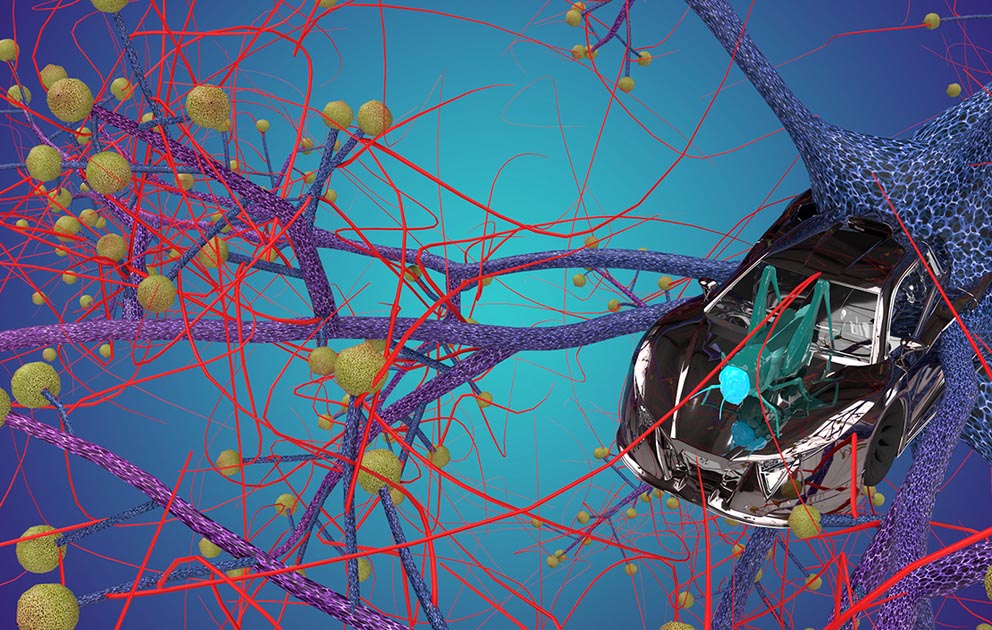
A collision detector for vehicles mimics an avoidance neuron in locusts that allows them to fly in swarms. IMAGE: JENNIFER M. MCCANN, PENN STATE
Locust swarm could improve collision avoidance
8/24/2020
By A’ndrea Elyse Messer
UNIVERSITY PARK, Pa. — Plagues of locusts, containing millions of insects, fly across the sky to attack crops, but the individual insects do not collide with each other within these massive swarms. Now a team of engineers is creating a low-power collision detector that mimics the locust avoidance response and could help robots, drones and even self-driving cars avoid collisions.
“We are always looking for animals with unusual abilities, ones that do something better than humans,” said Saptarshi Das, assistant professor of engineering science and mechanics. “Insect vision is something people use regularly to design automatic systems because they fly and don’t collide, but then we found locusts are unique.”
Locusts are unusual because they use a single, specialized neuron, called the Lobula Giant Movement Detector (LGMD), to avoid collisions.
“So we started looking at how it works and, locusts are just incredible,” said Das. “What these creatures can do is very humbling.”
According to Darsith Jayachandran, graduate student in engineering science and mechanics, the neuron receives two different signals. An image of an approaching locust falls on the avoiding locust’s eye. The closer the invading locust gets, the larger the image and the stronger this excitation signal becomes. The other input is the change in angular velocity of the invading locust with respect to the avoiding locust.
“Because the neuron has two branches, the locust computes the changes in these two inputs and realizes that something is going to collide,” said Jayachandran. “So the avoiding locust changes direction.”
The researchers developed a compact, nanoscale collision detector using monolayer molybdenum sulfide as a photodetector. They placed the photo detector on top of a programmable floating gate memory architecture that can mimic the locust’s neuron response using only a tiny amount of energy.
They report in today’s (Aug. 24) issue of Nature Electronics that this “is a leap forward towards the development of smart, low-cost, task-specific, energy efficient and miniaturized collision-avoidance systems.”
According to the researchers, locusts move at two to three miles per hour and make directional changes in hundreds of milliseconds. The decision to move employs non-linear mathematics and a miniscule energy expenditure.
This quick reaction and modest energy use is attractive for mechanized collision detectors. Current detectors for autonomous automobiles are very large and very heavy. The researchers’ collision detector responds in two seconds. Also, rather than be a jack-of-all trades detector, the molybdenum sulfide-based sensor is task specific, but because it is so small and uses so little energy, that is acceptable, according to the researchers.
The photodetector causes an increase in device current in response to an oncoming object, the excitatory signal, while the underlying programmable memory stack always causes a decrease in the current, the inhibitory signal. When an object approaches, the excitatory signal is added to the inhibitory stimuli, causing a non-monotonic change in the device current, mimicking the escape response of the LGMD neuron found in locusts.
“While locusts can only avoid collisions with other locusts, our device can detect potential collisions of a variety of objects at varying speeds,” said Das.
At this point, the researchers have only tested the device with objects on a direct collision path. They still need to optimize the responses for additional situations.
“We can’t do every measurement, every situation,” said Aaryan Oberoi, graduate student in engineering science and mechanics. “So we developed a numerical model. We can also test if multiple devices on the same chip would work better. So far, it looks like a single device will be sufficient. However, a multi-pixel collision detector array can offer collision avoidance in 3D space.”
Also working on this project from Penn State are Amritanand Sebastian, graduate student in engineering science and mechanics; Tanushree H. Choudhury, assistant research professor, 2D Crystal Consortium – Materials Innovation Platform; and Joan M. Redwing, professor of materials science and engineering, chemistry engineering and electrical engineering, and associate director of the Materials Research Institute.
Balakrishnan Shankar, associate dean for the School of Engineering, professor, head of the department, and the chairperson at the Department of Mechanical Engineering, Amritapuri campus of Amrita Vishwa Vidyapeetham, also participated in this work.
The U.S. Air Force Office of Scientific Research, U.S. Army Research Office and the National Science Foundation supported this work. The researchers have filed a provisional U.S. patent on this technology.



